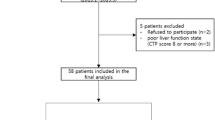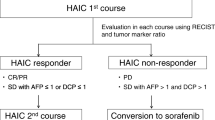Abstract
Purpose
The aim of this retrospective cohort study was to clarify the effect of a branched-chain amino acids (BCAA) on the liver function and the prognosis of Child-Pugh class (C-P) A and B liver cirrhosis (LC) patients with advanced hepatocellular carcinoma (aHCC) undergoing hepatic arterial infusion chemotherapy (HAIC).
Methods
Ninety-two adult Japanese patients with LC and aHCC underwent HAIC. They were in C-P A or B, and they showed multiple partial responses or stable disease. We excluded 11 patients classified as C-P C and 47 patients who showed no response. The patients were divided into an HAIC group receiving HAIC alone (n = 43) and a BCAA group treated with HAIC plus BCAA (n = 49). HAIC was delivered via the proper hepatic artery. The BCAA group also received oral administration of BCAA.
Results
In the BCAA group, serum albumin increased significantly after HAIC, while there were no significant changes in serum total bilirubin, serum aminotransferases, prothrombin time, ascites, and hepatic encephalopathy. The C-P score decreased significantly after HAIC compared with before HAIC in C-P B patients, although there was no significant change in C-P A patients. Survival of the BCAA group was significantly longer than that of the HAIC group, with the median survival time being 426 versus 272 days for C-P B patients, although there was no significant difference for C-P A patients.
Conclusions
Branched-chain amino acids might improve the survival and C-P score by increasing serum albumin in C-P B patients with aHCC receiving HAIC.







Similar content being viewed by others
References
Llover JM, Ricci S, Mazzaferro V, Hilgard P, Gane E, Blanc JF, de Oliveira AC, Santoro A, Raoul JL, Forner A, Schwartz M, Porta C, Zeuzem S, Bolondi L, Greten TF, Galle PR, Seitz JF, Borbath I, Häussinger D, Giannaris T, Shan M, Moscovici M, Voliotis D, Bruix J (2008) SHARP Investigators Study Group. Sorafenib in advanced hepatocellular carcinoma. N Engl J Med 359:378–390
Moreno-Aspitia A, Morton RF, Hillman DW, Lingle WL, Rowland KM Jr, Wiesenfeld M, Flynn PJ, Fitch TR, Perez EA (2009) Phase II trial of sorafenib in patients with metastatic breast cancer previously exposed to anthracyclines or taxanes: North Central Cancer Treatment Group and Mayo Clinic Trial N0336. J Clin Oncol 27:11–15
Abou-Alfa GK, Schwartz L, Ricci S, Amadori D, Santoro A, Figer A, De Greve J, Douillard JY, Lathia C, Schwartz B, Taylor I, Moscovici M, Saltz LB (2006) Phase II study of sorafenib in patients with advanced hepatocellular carcinoma. J Clin Oncol 24:4293–4300 (PMID: 16908937)
Pinter M, Sieghart W, Graziadei I, Vogel W, Maieron A, Königsberg R, Weissmann A, Kornek G, Plank C, Peck-Radosavljevic M (2009) Sorafenib in unresectable hepatocellular carcinoma from mild to advanced stage liver cirrhosis. Oncologist 14:70–76
Kudo M, Izumi N, Kokudo N, Matsui O, Sakamoto M, Nakashima O, Kojiro M, Makuuchi M (2010) Management of hepatocellular carcinoma in Japan: consensus-based clinical practice guidelines proposed by the Japan Society of Hepatology (JSH) 2010 updated version. Dig Dis 29:339–364
Toyoda H, Nakano S, Kumada T, Takeda I, Sugiyama K, Osada T, Kirishima S, Suga T, Takahashi M (1995) The efficacy of continuous local arterial infusion of 5-fluorouracil and cisplatin through an implanted reservoir for severe advanced hepatocellular carcinoma. Oncology 52:295–299
Murata K, Shiraki K, Kawakita T, Yamamoto N, Okano H, Nakamura M, Sakai T, Deguchi M, Ohmori S, Nakano T (2003) Low-dose chemotherapy of cisplatin and 5-fluorouracil or doxorubicin via implanted fusion port for unresectable hepatocellular carcinoma. Anticancer Res 23:1719–1722
Okuda K, Tanaka M, Shibata J, Ando E, Ogata T, Kinoshita H, Eriguchi N, Aoyagi S, Takikawa K (1999) Hepatic arterial infusion chemotherapy with continuous low dose administration of cisplatin and 5-fluorouracil for multiple recurrence of hepatocellular carcinoma after surgical treatment. Oncol Rep 6:587–591
Nagai H, Sumino Y (2008) Therapeutic strategy of advanced hepatocellular carcinoma by using combined intra-arterial chemotherapy. Recent Pat Anticancer Drug Discov 3:220–226
Nagai H, Kanayama M, Higami K, Momiyama K, Ikoma A, Okano N, Matsumaru K, Watanabe M, Ishii K, Sumino Y, Miki K (2007) Twenty-four hour intra-arterial infusion of 5-fluorouracil, cisplatin, and leucovorin is more effective than 6-hour infusion for advanced hepatocellular carcinoma. World J Gastroenterol 13:280–284
Moriwaki H, Miwa Y, Tajika M, Kato M, Fukushima H, Shiraki M (2004) Branched-chain amino acids as a protein- and energy-source in liver cirrhosis. Biochem Biophys Res Commun 313:405–409
Kondrup J, Muller MJ (1997) Energy and protein requirements of patients with chronic liver disease. J Hepatol 27:239–247
Marchesini G, Bianchi G, Merli M, Amodio P, Panella C, Loguercio C, Rossi Fanelli F, Abbiati R (2003) Nutritional supplementation with branched-chain amino acids in advanced cirrhosis: a double-blind, randomized trial. Gastroenterology 124:1729–1801 (PMID: 12806613)
Muto Y, Sato S, Watanabe A, Moriwaki H, Suzuki K, Kato A, Kato M, Nakamura T, Higuchi K, Nishiguchi S, Kumada H (2005) Effects of oral branched-chain amino acid granules on event-free survival in patients with liver cirrhosis. Clin Gastroenterol Hepatol 3:705–713
Charlton M (2006) Branched-chain amino acid enriched supplements as therapy for liver disease. J Nutr 136:295S–298S
Hayashi S, Chung H, Kudo M, Ishikawa E, Takita M, Ueda T, Kitani S, Inoue T, Yada N, Hagiwara S, Minami Y, Ueshima K (2011) Oral branched-chain amino acid granules reduce the incidence of hepatocellular carcinoma and improve event-free survival in patients with liver cirrhosis. Dig Dis 29:326–332
Harima Y, Yamasaki T, Hamabe S, Saeki I, Okita K, Terai S, Sakaida I (2010) Effects of a late evening snack using branched-chain amino acid-enriched nutrients in patients undergoing hepatic arterial infusion chemotherapy for advanced hepatocellular carcinoma. Hepatol Res 40:574–584
Iwamiya T, Sawada S, Ohta Y (1994) Repeated arterial infusion chemotherapy for inoperable hepatocellular carcinoma using an implantable drug delivery system. Cancer Chemother Pharmacol 33:S134–S138
Yamasaki T, Kurokawa F, Shirahashi H et al (2002) Novel arterial infusion chemotherapy using cisplatin, 5-fluorouracil, and leucovorin for patients with advanced hepatocellular carcinoma. Hepatol Res 23:7–17
Italian Multicentre Cooperative Project on Nutrition in Liver Cirrhosis (1994) Nutritional status in cirrhosis. J Hepatol 21:317–325
Swart GR, Zillikens MC, van Vuure JK, van den Berg JW (1989) Effect of a late evening meal on nitrogen balance in patients with cirrhosis of the liver. BMJ 299:1202–1203
Zillikens MC, van den Berg JW, Wattimena JL, Rietveld T, Swart GR (1993) Nocturnal oral glucose supplementation. The effects on protein metabolism in cirrhotic patients and in healthy controls. J Hepatol 17:377–383
Miwa Y, Shiraki M, Kato M, Tajika M, Mohri H, Murakami N, Kato T, Ohnishi H, Morioku T, Muto Y, Moriwaki H (2000) Improvement of fuel metabolism by nocturnal energy supplementation in patients with liver cirrhosis. Hepatol Res 18:184–189
Nakaya Y, Okita K, Suzuki K, Moriwaki H, Kato A, Miwa Y, Shiraishi K, Okuda H, Onji M, Kanazawa H, Tsubouchi H, Kato S, Kaito M, Watanabe A, Habu D, Ito S, Ishikawa T, Kawamura N, Arakawa Y, Hepatic Nutritional Therapy (HNT) Study Group (2007) BCAA-enriched snack improves nutritional state of cirrhosis. Nutrition 23:113–120
Okamoto M, Sakaida I, Tsuchiya M, Suzuki C, Okita K (2003) Effect of late evening snack on the blood glucose level and energy metabolism in patients with liver cirrhosis. Hepatol Res 27:45–50
Sakaida I, Tsuchiya M, Okamoto M, Okita K (2004) Late evening snack and the change of blood glucose level in patients with liver cirrhosis. Hepatol Res 30S:67–72
Tsuchiya M, Sakaida I, Okamoto M, Okita K (2005) The effect of a late evening snack in patients with liver cirrhosis. Hepatol Res 31:95–103
Lam VW, Poon RT (2008) Role of branched-chain amino acids in management of cirrhosis and hepatocellular carcinoma. Hepatol Res 38:107–115
Poon RT, Yu W, Fan S, Wong J (2004) Long-term oral branched chain amino acids in patients undergoing chemoembolization for hepatocellular carcinoma: a randomized trial. Aliment Pharmacol Ther 19:779–788
Muto Y, Sato S, Watanabe A, Moriwaki H, Suzuki K, Kato A, Kato M, Nakamura T, Higuchi K, Nishiguchi S, Kumada H, Long-Term Survival Study Group (2005) Effects of oral branched-chain amino acid granules on event-free survival in patients with liver cirrhosis. Clin Gastroenterol Hepatol 3:705–713
Yoshida T, Muto Y, Moriwaki H, Yamato M (1989) Effect of long-term oral supplementation with branched-chain amino acid granules on the prognosis of liver cirrhosis. Gastroenterol Jpn 24:692–698
Ijichi C, Matsumura T, Tsuji T, Eto Y (2003) Branched-chain amino acids promote albumin synthesis in rat primary hepatocytes through the mTOR signal transduction system. Biochem Biophys Res Commun 303:59–64
Matsumura T, Morinaga Y, Fujitani S, Takehara K, Nishitani S, Sonaka I (2005) Oral administration of branched-chain amino acids activates the mTOR signal in cirrhotic rat liver. Hepatol Res 33:27–32
Author information
Authors and Affiliations
Corresponding author
Rights and permissions
About this article
Cite this article
Kanekawa, T., Nagai, H., Kanayama, M. et al. Importance of branched-chain amino acids in patients with liver cirrhosis and advanced hepatocellular carcinoma receiving hepatic arterial infusion chemotherapy. Cancer Chemother Pharmacol 74, 899–909 (2014). https://doi.org/10.1007/s00280-014-2564-z
Received:
Accepted:
Published:
Issue Date:
DOI: https://doi.org/10.1007/s00280-014-2564-z




